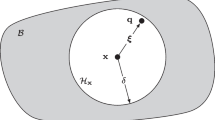Abstract
The radiosity method is usually employed for the rendering of highly realistic synthetic images. In this paper we present an implementation of the Monte Carlo radiosity algorithm on the GPU using CUDA. Our proposal is based on the partition of the scene into sub-scenes to be processed in parallel to exploit the graphics card structure. The convex partition method employed permits the exploitation of data locality and the optimization of the ray shooting procedure due to the minimization of the number of objects to be tested in the intersection calculation. The results are good in terms of execution times, increasing the flexibility of previous solutions and demonstrating that the GPU can outperform the CPU results even for non-regular algorithms.
Similar content being viewed by others
References
Amor M, Sanjurjo JR, Padrón EJ, Doallo R (2004) Progressive radiosity method on clusters using a new clipping algorithm. Int J High Perform Comput Netw (IJHPCN) 1:55–63
ATI: ATI Stream Computing (2009)
Cheslack-Postava E, Wang R, Akerlund O, Pellacini F (2008) Fast realistic lighting and material design using nonlinear cut approximation. ACM Trans Graph (TOG) 27(5):128
Dachsbacher C, Stamminger M, Drettakis G, Durand F (2007) Implicit visibility and antiradiance for interactive global illumination. ACM Trans Graph (TOG) 26(3):61
Dutre P, Bekaert P, Bala K (2006) Advanced global illumination, 2nd edn. AK Peters, Wellesley
Havran V (2001) Heuristic ray shooting algorithms. Ph.D. thesis, Czech Technical University in Prague
Laine S, Saransaari H, Kontkanen J, Lehtinen J, Aila T (2007) Increment instant radiosity for real-time indirect illumination. In: Proc. eurographics symposium on rendering, pp 277–286
Neumann L, Purgathofer W, Tobler RF, Neumann A, Elias PP, Feda M, Pueyo X (1995) The stochastic ray method for radiosity. In: Proc. of the rendering techniques, pp 206–218
NVIDIA: NVIDIA CUDA compute unified device architecture. Programming guide (2008)
Ritschel T, Grosh T, Kim MH, Seidel H-P, Dachsbacher C, Kautz J (2008) Imperfect shadow maps for efficient computation of indirect illumination. ACM Trans Graph (TOG) 27(5):129
Author information
Authors and Affiliations
Corresponding author
Rights and permissions
About this article
Cite this article
Sanjurjo, J.R., Amor, M., Bóo, M. et al. Optimizing Monte Carlo radiosity on graphics hardware. J Supercomput 58, 177–185 (2011). https://doi.org/10.1007/s11227-009-0353-y
Published:
Issue Date:
DOI: https://doi.org/10.1007/s11227-009-0353-y




